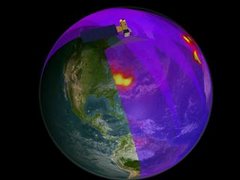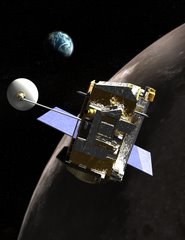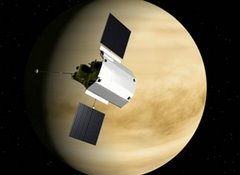
I'm at the Discovery@15 Conference in Huntsville, AL. From the NASA Discovery website:
In space exploration, the possibilities for discovery are without limits. Even with the vast amount of knowledge gained since exploration of our solar system began, there are still more questions than answers.
NASA's Discovery Program gives scientists the opportunity to dig deep into their imaginations and find innovative ways to unlock the mysteries of the solar system. It represents a breakthrough in the way NASA explores space, with lower-cost, highly focused planetary science investigations designed to enhance our understanding of the solar system.
All completed Discovery missions have achieved ground-breaking science within strict cost and schedule limitations, each taking a unique approach to space exploration.
Reaching into the unknown, doing what's never been done before, and driving new technology innovations that may also improve life on Earth - this is NASA's Discovery Program.
I'll be adding my twitter comments throughout the meeting
is now in work mode tweeting from the Discover @ 15 meeting http://discovery.nasa.gov/Discovery15/
just announced that all presentations will be video taped and podcast on the website http://discovery.nasa.gov/D... eventually!
First up Bob Farquhar who worked on 3 Discovery missions including NEAR, Contour and MESSENGER http://tinyurl.com/26aqrn
or more info about the Discovery missions check out http://discovery.nasa.gov/ ... I'm the education and out reach lead for MESSENGERmore on Bob Farquhar http://www.jamesoberg.com/eros.html
Now Discovery Sample return missions: 1st up Stardust..it flew through the tail of a comet http://stardust.jpl.nasa.gov
read about aerogel: http://stardust.jpl.nasa.gov/tech/aerogel.html 99.8% air used to collect comet tail dustIf you want to find comet dust in aerogel check out Stardust at home http://stardustathome.ssl.berkeley.edu/
30,000 volunteers are already participating in Stardust @ home stardustathome.ssl.berkeley.edu/ perk-you get to name the grains you find
Next up the Genesis mission that returned samples of the solar wind http://genesismission.jpl.nasa.gov
The speaker for Genesis is Don Burnett http://genesismission.jpl.nasa.gov/people/index.html
Genesis sampled high speed, low speed and Coronal Mass Ejections see mission gallery http://genesismission.jpl.nasa.gov/mission/gallery.htmlDon is discussing some of the challenges related to the Genesis hard landing http://curator.jsc.nasa.gov/genesis/field.cfm
amazing results are coming from research on the Genesis solar wind samples http://tinyurl.com/yyphws
Next up-- Technology Innovation thru the Discovery Missions--enabling technologies in a cost-capped program
Bill Borucki is talking about Kepler http://kepler.nasa.gov/ the mission to search for habitable planets outside of the Solar System
Kepler uses 42 CCDs covered in sapphire http://kepler.nasa.gov/sci/design/spacecraft.html
"How can you quantify science? Its of infinite value" Bill Bourcki when asked quantify science value when Kepler was faced w/ budget cuts
Next up MESSENGER "How can you not like the planet Mercury?" MESSENGER Principal Investigator Sean Solomon
The challenges to a Mercury orbiter....Mercury is very close to the sun...only spacecraft to visit Mercury is Mariner 10 in 1974- a flyby
MESSENGER website http://MESSENGER.jhuapl.edu
now Discovery "Missions of OpportunityTechnology infusion for MESSENGER-46% of the mass of the spacecraft is fuel..needed to integrate structure and propulsion system.
....including specially designed tank on MESSENGER..total of 17 thrusters-given 1 Earth, 2 Venus and 3 Mercury flybys before orbit insertion
The sun is 11 times brighter at Mercury than earth...lead to ceramic cloth sunshade..behind the sunshade MESSENGER is room temperature
don't forget first Mercury flyby is Jan 14 2008 the first spacecraft results from Mercury in more than 32 yearsThe Dawn Mission technology infusion is Ion Propulsion-learn more at http://tinyurl.com/28zsnf
Dawn is scheduled to launch Sept 26th...it will visit two asteroids, Ceres and Vesta http://dawn.jpl.nasa.gov/
The Discovery program supports international cooperation through Missions of Opportunity with international space agencies
ASPERA-3 is a suite of instruments on the European Space Agency's Mars Express spacecraft http://www.aspera-3.org/
Moon Mineralogy Mapper will fly on the Chandrayaan-1 spacecraft-- India' s first mission to moon http://moonmineralogymapper.jpl.nasa.gov
This official launch date of Chandyayann-1 is April 2008 http://www.isro.org/chandrayaan/htmls/home.htm

M-cubed is a spectrometer with 260 spectral channels and 70 m resolution. So we will have high resolution maps of the elements on the moon







1 comment:
Excellent to see you twittering/liveblogging the meeting, Stephanie! We'll have to catch up at the break....
Post a Comment